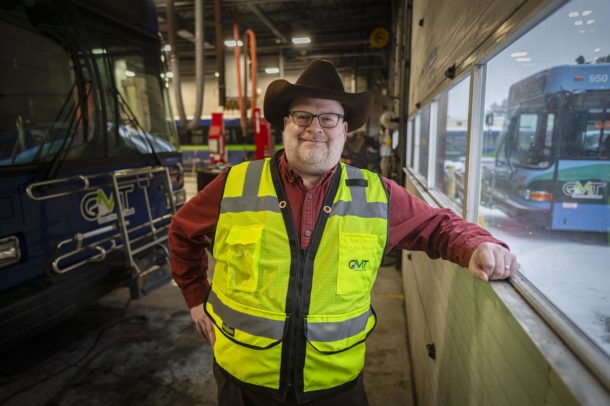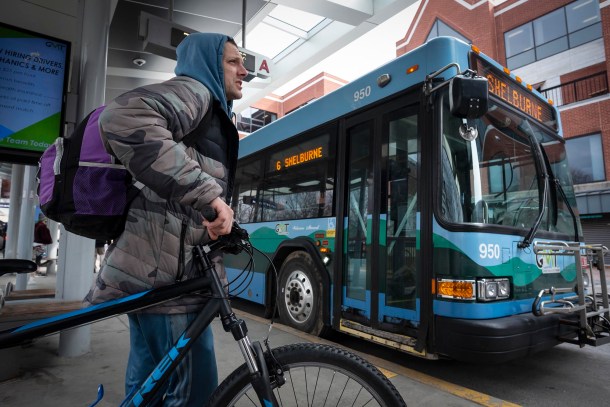
BURLINGTON — Just as an interview was winding down on a recent snowy afternoon at the Green Mountain Transit headquarters in Burlington, Clayton Clark picked up a cowboy hat off a table in his office. He slipped it onto his head, and threw out a prediction.
“By the end of the (legislative) session, everybody’s going to know that the guy in the cowboy hat is the guy from GMT,” Clark said. “If I just, you know, blended in, I think it would be harder for me to advocate for the organization.”
Clark is just weeks into his new job as general manager of Vermont’s largest regional public transportation network, and is the first to admit that he has a lot to learn. His background is not in transit, but in human services. He spent almost two decades working for the state, and most recently headed up a Burlington long-term care facility.
But Clark said he thinks his background as “a bureaucrat” will also help him be a strong voice for Green Mountain Transit in Montpelier. He has stepped into the agency’s driver’s seat as it faces substantial challenges. It has a critical shortage of bus drivers at the same time as it battles rising costs and stares down questions about how to fund its services over the next several years once federal Covid-19 relief money, which has buoyed the agency during the pandemic, is no longer available.
Clark stopped short of calling the agency’s financial situation an immediate emergency. “But we are going to be confronting, in the next 18 to 24 months, some real challenges that are likely going to lead us to either make hard decisions, or come up with new ways to gather funds,” he said. So perhaps more than ever this year, Clark said, the agency will need “to tell the story of GMT.”
“And that’s to our communities, that’s our municipalities — that’s to the state,” he said, as buses rolled by his office window.
Green Mountain Transit’s operating budget for the 2024 fiscal year, which starts in July, reflects those challenges. To balance its books, the agency has said it will need to start charging fares again on its routes in Chittenden County — known as its urban system — for the first time since the outset of the pandemic. It also plans to make permanent a slate of service reductions, including longer amounts of time between buses on some routes, that have been in place throughout the pandemic.
Clark said the agency does not have enough drivers to reverse those cuts, even if it wanted to. He noted that about a third of the agency’s routes in Chittenden County can currently operate only because drivers are working contractually obligated overtime.
“That’s an operational tempo that I’m not sure is sustainable long-term,” Clark said. “I’m pretty sure it’s not.”

Green Mountain Transit has also said that an expected overall decline in federal, state and local revenue in the 2024 fiscal year led it to decide to reinstate fares.
A majority of the agency’s funding for both its urban and rural services comes from the federal government. It also receives state funding, which comes from sources that include motor fuel taxes, vehicle purchase and use taxes, and license and registration fees. (This is also true of other public transit providers across Vermont.)
The agency also funds about 20% of its urban budget, and about 8% of its rural budget, with local property taxes and sales taxes in the communities it serves. Green Mountain Transit plans to ask some of those cities and towns for more money in the upcoming fiscal year than they currently provide. That includes, at the top of the list, a roughly 12% increase in Burlington, which agency officials said is tied to an increased demand for Americans with Disabilities Act paratransit services in the city.
Green Mountain Transit relies on these member community assessments to match federal transit funding for its services.
In fiscal year 2024, the agency estimates it will bring in, and spend, just over $26 million. That includes fare revenue from Chittenden County, though state lawmakers are likely to once again debate whether the fares should be reinstated this year.
A legislative report issued last month lays out some pros and cons. The report estimates that if Green Mountain Transit continues to operate fare-free in the 2024 fiscal year, it would gain about 340,000 more urban system riders but forgo about $1.9 million in revenue. Fare-free service would also increase demand for the agency’s paratransit services, the report says, creating an overall gap in its 2024 budget of more than $2 million.
Meanwhile, the study estimates that continuing fare-free service outside of Chittenden County would also increase ridership there, though result in far less lost revenue. Green Mountain Transit’s rural routes accounted for a small fraction of pre-pandemic revenue compared to its Burlington-area routes, agency officials have said.
“There is, thus, a strong case to be made for a continuation of fare-free service outside of Chittenden County, but a reimposition of fares for GMT’s urban service,” the report states.
Overall, the study estimates that fiscal year 2023 public transit ridership in Chittenden County will be higher than it’s been since the outset of the pandemic, but still fall about 15% short of total ridership in the 2019 fiscal year, the year before the pandemic.
Green Mountain Transit was able to waive fares on its routes for the current fiscal year, which runs through June, only after state lawmakers approved a $1.2 million add-on to the state transportation budget last spring. That also allowed the agency to draw down additional federal money to restore full, fare-free service on two of its Chittenden County routes, and partial service for a commuter bus between Burlington and Montpelier.

But public transportation advocates have said the agency — and its peers across the state — need more reliable, sustainable funding to ensure that they can meet their communities’ needs. Some have pointed to recommendations in a November 2021 transit financing study commissioned by the Chittenden County Regional Planning Commission, which details alternatives to fares and taxes at the municipal level.
Jon Moore, Green Mountain Transit’s assistant general manager — who was the general manager before Clark came on board — said last month that he expected the agency to advocate for lawmakers to consider that study this year.
The study recommends that Vermont find a universal, statewide funding source for public transit, instead of relying on contributions from towns. Two options it ranks highly are additional fees on utility bills, or new, countywide property taxes. The study estimated the cost of public transit, when divided per capita, would come to less than $10 per Vermont resident, per year.
Alternative funding options for transit have been studied multiple times before, the 2021 study states, but changes have not been made “mainly because GMT and the rural transit providers in Vermont have found ways to obtain sufficient funding without facing a serious crisis.”
Sandy Thibault, executive director of the Chittenden Area Transportation Management Association, said she would like to see the Legislature “really dig in” to the alternatives in the 2021 study this year. Thibault also said she supports sustaining fare-free service.
“We’re at such a critical moment right now,” Thibault said. “We need to work together to develop a compelling plan to maintain our system, and expand our system.”
Concerns over transportation funding have also reached the local level. A resolution adopted by the Burlington City Council last month calls on state lawmakers “to prioritize the advancement of more sustainable mass transit funding models,” including those outlined in the regional planning commission study.
The resolution states that the nearly 12% planned increase in Burlington’s share of Green Mountain Transit funding “reflects the unsustainability of the current funding model while the decrease in service and reintroduction of fares pushes the transit system in the opposite direction of where Vermont needs it to be going given the climate emergency.”
Sen. Dick Mazza, a Democrat representing Grand Isle County and longtime chair of the Senate Committee on Transportation, said he expects lawmakers to consider once again providing an add-on to the transportation budget this year for fare-free service. He also expects the Legislature to examine some more universal funding options for public transit as part of “ongoing discussion about where the money comes from,” he said.
The state Agency of Transportation, meanwhile, does not support implementing any of the recommendations in the 2021 study, according to Michele Boomhower, the agency’s director of policy, planning and intermodal development.

Boomhower said it can be difficult for some municipalities — especially those where transit access is already scant — to justify raising the money to support an agency such as Green Mountain Transit. But Republican Gov. Phil Scott’s administration, she continued, is wary of creating new assessments on Vermonters amid high inflation and in a year when many communities are slated for property reappraisals.
“We would not be looking to increase any fees or taxes to create a revenue stream for public transit outside of the framework of state funding and local funding that has historically supported that system,” Boomhower said in an interview.
Scott’s proposed budget for the 2024 fiscal year includes about $49 million for public transit, which is an increase over the current year’s budget. Joe Flynn, the Agency of Transportation secretary, told lawmakers last week that this funding would allow all of the state’s public transportation providers to maintain their current levels of service.
The 2021 study notes that Vermont has been “many times more generous than other rural states” in devoting its transportation funds that come from automobile-based uses to public transit.
Mazza also said that, since more than a quarter of Vermont’s transportation revenue today comes from fuel taxes, lawmakers need to identify new funding sources for services, including public transit, as more people buy electric vehicles. The state’s climate action plan calls for 40% of new vehicle sales to be electric by 2025.
Clark, of Green Mountain Transit, said he sees those policy conversations as an opportunity. The agency has been “surviving” during the pandemic so far, he said, but he wants it to be “thriving” — which will take figuring out how to attract more drivers and, ultimately, expand the services it offers riders.
“My hope is that, because we’re going to have to have a real fundamental, big-picture change in how funds are raised for transportation,” Clark said, “perhaps how funds are raised for public transportation would be part of that discussion.”

